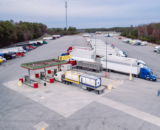/// Guest post by contributor Jon Scharingson, Renewable Energy Group
American trucking firms and owner-operators can take advantage of a growing number of sustainability options in their fleets. Your travel center may be considering how it can meet the demands from fleets interested in natural gas, electric hybrids and biodiesel blends. While the nation needs a diversified fuel strategy, biodiesel continues to be the drop-in fuel choice for retail fuel infrastructure and fleet engines.
Biodiesel does not face a “blend wall.” Nearly any biodiesel blend percentage can be used in existing diesel engines without modifications. Retail fuel pumps are already manufactured to offer biodiesel at blends greater than B20 (a blend of 20 percent by volume biodiesel with 80 percent by volume petroleum diesel).
Every diesel engine in Minnesota runs on biodiesel 365 days of the year. Several fleets in Peoria, Illinois run on B20 year-round. Mining operations across the country use biodiesel blends of 80 percent (B80) or more to meet their underground air emission requirements. Both passenger vehicles and heavy-duty equipment in Europe have been using biodiesel blends for decades.
Biodiesel is an efficient, lower cost option. Because biodiesel can be used in any existing diesel engine and with current retail fueling systems, it essentially removes the initial capital costs required for making a change to a more sustainable fuel. With the implementation of the Renewable Fuel Standard (RFS2), biodiesel is becoming increasingly more available across the petroleum supply chain.
Truly a renewable fuel. Biodiesel is produced from the leftover fats, oil and greases produced by processing and manufacturing food. The more food the American farmer produces, the more raw materials are available for producing biodiesel. With this renewable cycle, harmful greenhouse gas emissions are reduced by up to 86% as compared to petroleum diesel .
The higher the blend, the better. B20 has demonstrated significant environmental benefits with a minimum increase in cost for fleet operations and other fuel consumers. When a fleet first moves to higher blends like B20, they can expect their engines to be “cleaned.” Biodiesel is cleaner than diesel fuel and, as a cleaning agent, reduces particulate build-up in the engine which may clog fuel filters initially. In the long run, biodiesel enhances engine performance with a cleaner, more efficient burn and optimized efficiency.
Biodiesel is an American-made, drop-in advanced biofuel available for integration today. Ask your diesel provider for a biodiesel blend with your next delivery as way to help your customers meet their sustainability goals.
/// Read more guest posts on biodiesel posts here.
{Guest Post} Guest post provided by NATSO Chairman's Circle member Jon Scharingson, Renewable Energy Group. Renewable Energy Group® is a leading North American biodiesel producer with a nationwide distribution and logistics system. With more than 210 million gallons of owned/operated annual production capacity at biorefineries across the country, REG is a proven biodiesel partner in the distillate marketplace. Learn more about Renewable Energy Group.
The opinions and advice given by guest post contributors are not necessarily those of NATSO Inc. The posts should not be considered legal advice. Qualified professionals should be sought regarding advice and questions specific to your circumstances.
Subscribe to Updates
NATSO provides a breadth of information created to strengthen travel plazas’ ability to meet the needs of the travelling public in an age of disruption. This includes knowledge filled blog posts, articles and publications. If you would like to receive a digest of blog post and articles directly in your inbox, please provide your name, email and the frequency of the updates you want to receive the email digest.



